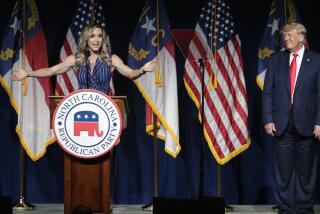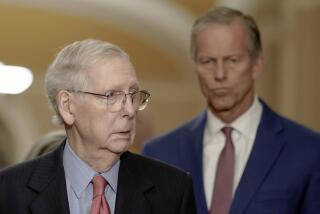Analysis: In President Trump’s wake, divisions mark both Democratic and Republican parties

Democrats and Republicans alike are divided over Trump these days. (May 31, 2017)
Six months after President Trump breached long-standing political boundaries to win the White House, the nation’s major political parties still muddle in his wake.
On the sun-swept lawn of the Hotel del Coronado two weeks ago, national Republican leaders sipped cocktails and listened to San Diego Mayor Kevin Faulconer, one of the party’s brightest lights in the most populous state, praise a brand of moderate Republicanism that looks nothing like the versions coming out of Washington — either the populism of the president or the more orthodox conservatism of congressional leaders.
A week later, Democratic National Committee Chairman Tom Perez talked in a Sacramento interview of the “remarkably constructive” debate under way in his party, characterizing its divisions as largely in the past. Within hours, he and other party leaders were booed as they welcomed delegates to a state convention that would be filled with persistent internal warfare on healthcare and other issues.
No political party is immune to disagreement; indeed the path to power often relies on combustible ideological diversity. But Democrats and Republicans alike seem particularly adrift and quarrelsome these days.
Part of the reason is the magnetic power of Trump, who has attracted Republicans and repelled Democrats with such force that the parties often seem to be defined solely in relation to him, for or against. That has left both parties’ images blurry rather than sharp.
Steve Schmidt, a Republican strategist who ran Arizona Sen. John McCain’s 2008 presidential campaign, sees both parties as having left their anchorages without new destinations in sight.
“The political parties have become divorced from their ideological roots; we saw that in the last election,” he said. “The Republican Party has become unmoored from the intellectual foundation of conservatism. Democrats are divorced from the realities of working people in their party, badly out of step.”
Both, he said “are held in contempt, as they should be.”
Indeed, a poll published in April by the nonpartisan Pew Research Center found Americans viewing both parties in a more negative light than three months earlier.
Only 40% of Americans had a favorable view of Republicans, down from 47% in January. Forty-five percent of Americans had a positive view of Democrats, down from 51% in January.
For Republicans, the path to full control of Washington led to the party’s divisions.
Republicans seized the Senate and House by electing candidates driven by differing emphases: tea party ardor, pro-business tax-cutting fervor or culturally conservative social views. (What was once a Republican orthodoxy, rigorous opposition to deficit spending, has mostly been lost).
House Speaker Paul D. Ryan (R-Wis.) has pressed tax cuts that primarily benefit wealthy Americans and cuts to programs for the less well-off, including support for the poor or sick, and reforms to Social Security.
Trump came into office advocating the opposite: protecting Social Security, Medicare and Medicaid, and spending on infrastructure. That view was embraced by his target audiences, voters in the industrial Midwest and Northeast who had previously sided with Democrats.
Trump since has leaned in the direction of congressional Republicans on healthcare and the budget, to the point that his budget has been criticized by some centrist Republicans as too draconian.
Trump’s supporters, of course, see his singular ideology as the way the party should go.
“It would be hard to say that Donald Trump isn’t the Republican Party,” said Ron Ferrance, GOP county chairman in Luzerne County in northeast Pennsylvania, which voted for President Obama in 2012 and flipped to Trump last November.
Trump’s version of Republicanism is so popular in that economically stressed county that voters still have Trump signs in their yards, Ferrance said. Some of the appeal centers on Trump’s deviation from the party’s traditional stances on issues such as trade and immigration.
“The main thing that people want in our area is to put America first and to feel safe,” he said. “He’s going to deliver that. That’s going to give him the buoyancy in 2020.”
Across the country in California, however, Mayor Faulconer argued for a Republican Party that sticks to jobs and sets aside hotter issues. He suggested — although he was not indiscreet enough to say so outright — that it was the only path forward in areas where Republicans are not already dominant.
In an interview, Faulconer touted his city’s close business ties with nearby Tijuana — hardly the “build the wall” message emanating from the president.
Asked about the discrepancy, Faulconer said that the area’s Latino community “helps define us.”
“Good quality jobs for both sides of the border,” he said. “That works for us.”
Democrats have no clearly defined leader or universally accepted direction aside from opposition to Trump.
Democrats essentially remain in the box where Hillary Clinton spent the general election: able to unify Trump opponents, but unable to craft a message for those not motivated by distaste for him.
“The Democrats are closer to where the electorate is headed, but have shown a tin ear and an inability to understand the groups that formed the backbone of the Democratic Party for decades,” said veteran Democratic pollster Peter D. Hart.
The deepest Democratic schisms involve whether to focus on liberal social issues or the economic struggles of blue-collar and middle-class Americans. During the presidential campaign, many voters saw the party as more intent on social issues, an image disputed by Democrats but pushed by Republicans.
“The Democratic Party, especially the presidential campaign, lost its core economic message last year; Trump sort of outmaneuvered us among Democrats and independents,” said Ohio Democratic Party Chairman David Pepper, who has spent the last few months in what he calls “kitchen conversations” with voters.
Supporting the civil rights of Democratic voter groups is admirable, he said, “but we can’t let them bait us into getting away from our core message — and I think that does happen.”
Party leaders in interviews expressed concern that the lesson may not have been learned.
Pete Buttigieg, the mayor of South Bend, Ind., and an unsuccessful candidate this year to head the Democratic National Committee, pointed to the issue of trade. Sen. Bernie Sanders (I-Vt.) energized a wide swath of Democrats by blaming trade deals for gutting jobs in the Midwest. That does not reflect reality, the mayor said, even if the idea has been embraced by many Democrats.
“We’ve got a lot of wins on the board from globalization,” he said of his city. “We’ve got auto workers making Mercedes cars … that are sold to China. Globalization doesn’t have to be a disaster for working people.”
But what could be disasters, he said, are seemingly unimportant economic developments touted by the party’s more elite factions, such as ride-sharing and driverless vehicles. The first threatens demand for cars, the second threatens demand for drivers, a significant employment option for blue-collar workers.
“Nobody in the political space is wrestling with it,” he said.
Perez, the national Democratic chairman, has spent months traveling the country to buck up Democrats with a relentless focus on what he sees as Trump’s failings. Yet he sees his own party’s failings as well.
“Just fighting against Donald Trump isn’t enough, and I’ve heard that clearly from voters,” he said. “I’ve heard from voters that they don’t know what the Democratic Party stands for — and that’s why we’re out there.”
What it stands for, he says, is “economic opportunity, good jobs for everyone, ladders of opportunity for everyone … healthcare a right for all, not a privilege for the few.”
“When we get out there and fight for those values, that’s how we succeed.”
But divisions persist over those very issues. In the weeks leading to special House elections this spring, party activists feuded over whether candidates were supportive enough of abortion rights or populist enough in their economic leanings. At town halls, veteran Democrats such as California Sen. Dianne Feinstein were excoriated by more liberal Democrats for not supporting universal healthcare. (She favors repairing Obamacare.)
At a Los Angeles town hall meeting featuring California Sen. Kamala Harris, Kristin Morley, a real estate agent from Valley Village, said she feared that clashes among Democrats would doom the party in coming elections by dissuading some from showing up to vote.
In some activist groups to which she belongs, even the popular Harris has been sharply criticized for warning against ideological litmus tests, she said, adding: “I am terrified by the fact that there is such division in the Democratic Party.”
Twitter: @cathleendecker
ALSO:
Rep. Adam Schiff calls for unity in speech that suggests ambitions for himself
Updates on California politics
More to Read
Get the L.A. Times Politics newsletter
Deeply reported insights into legislation, politics and policy from Sacramento, Washington and beyond. In your inbox three times per week.
You may occasionally receive promotional content from the Los Angeles Times.






